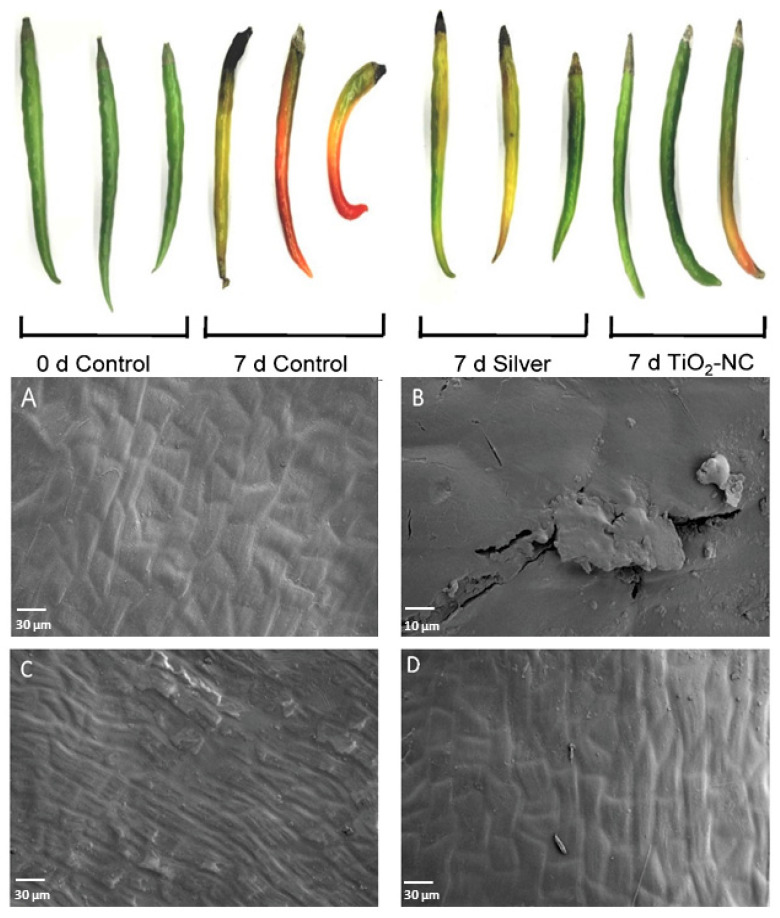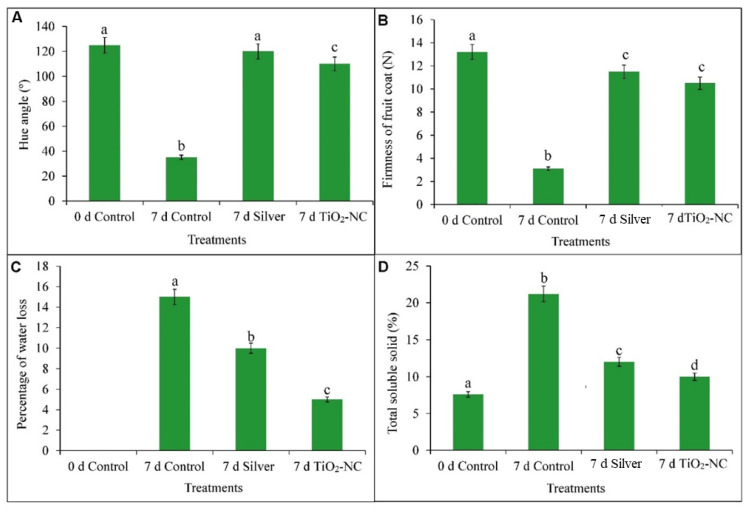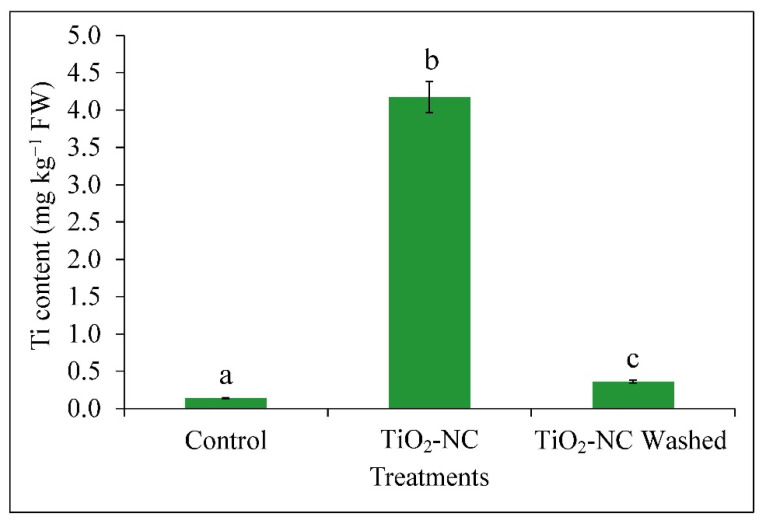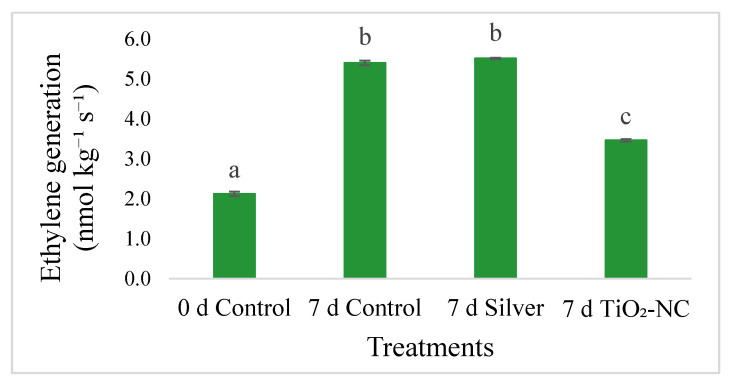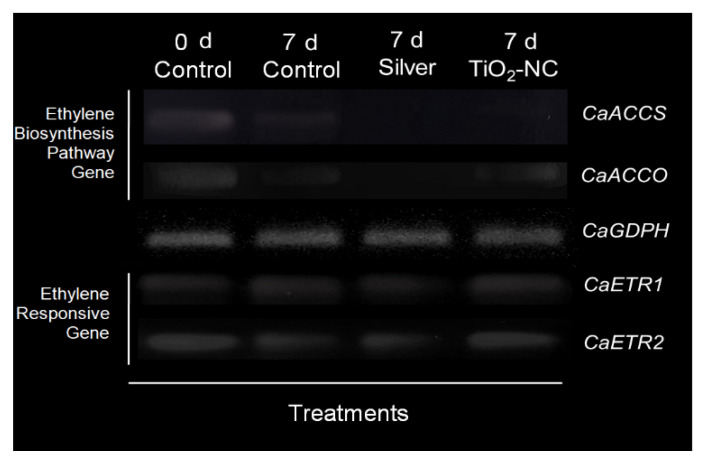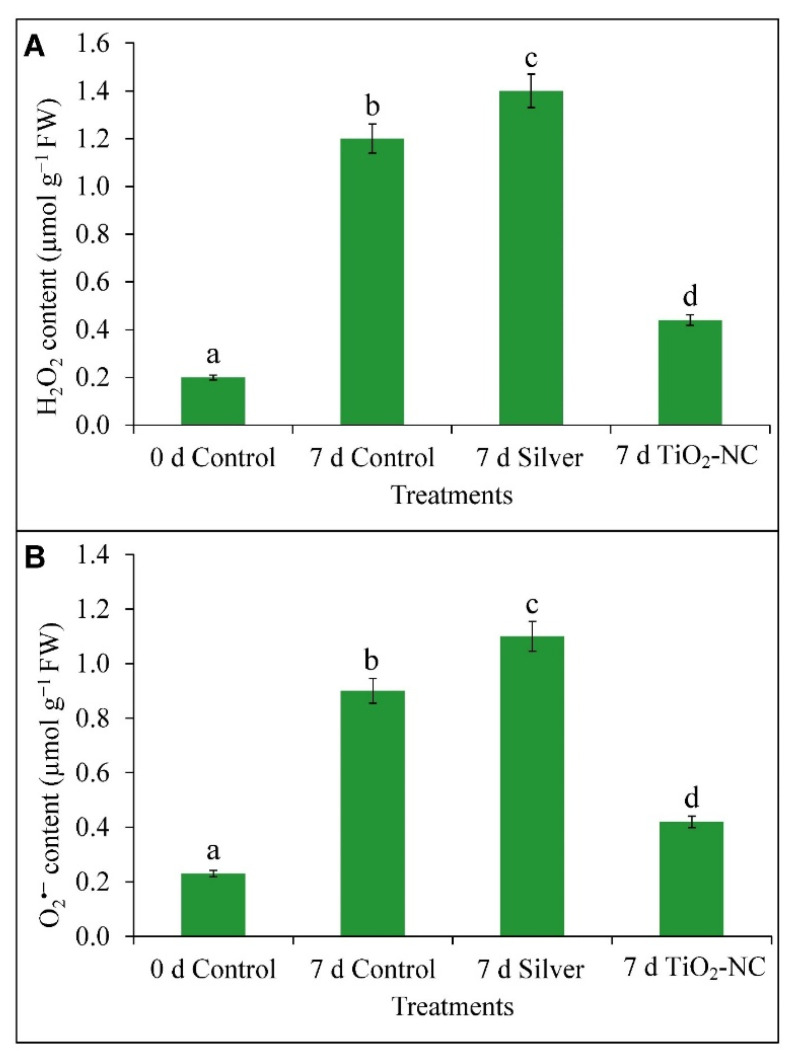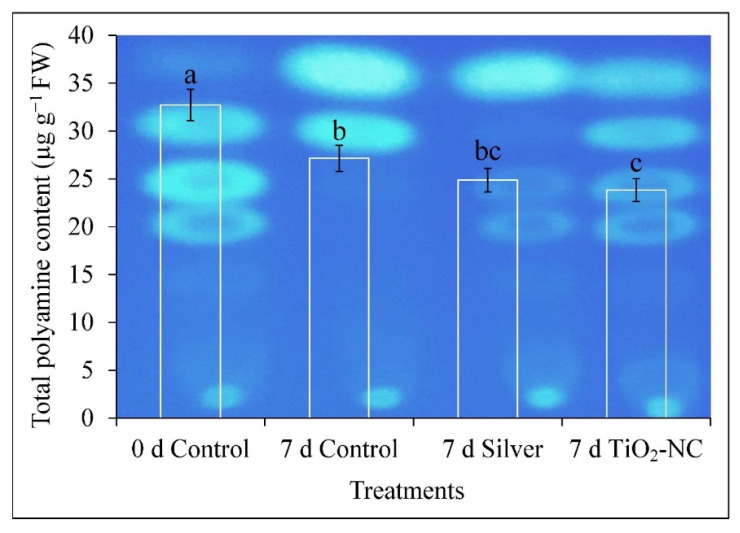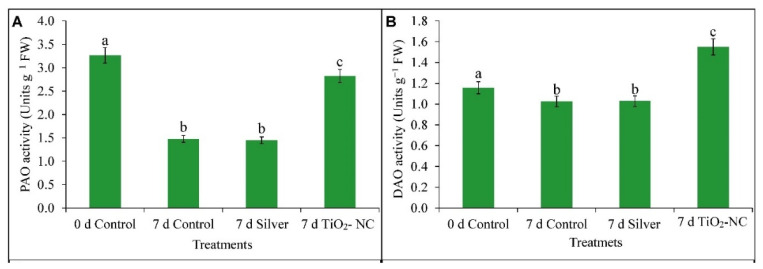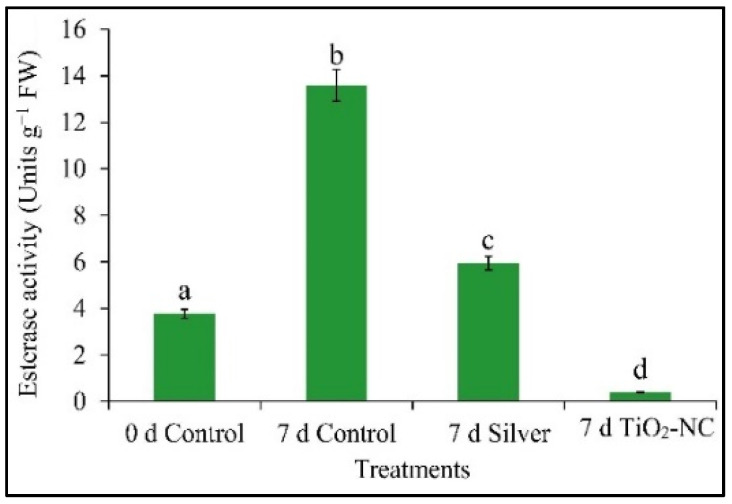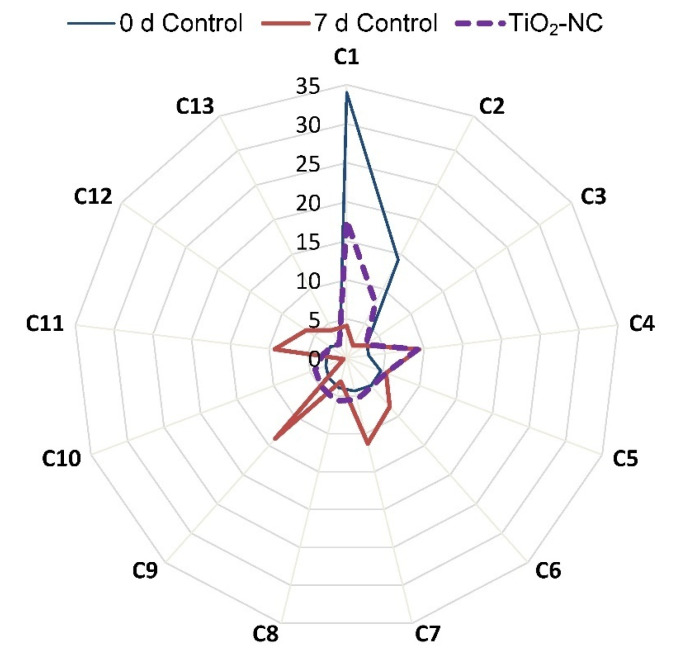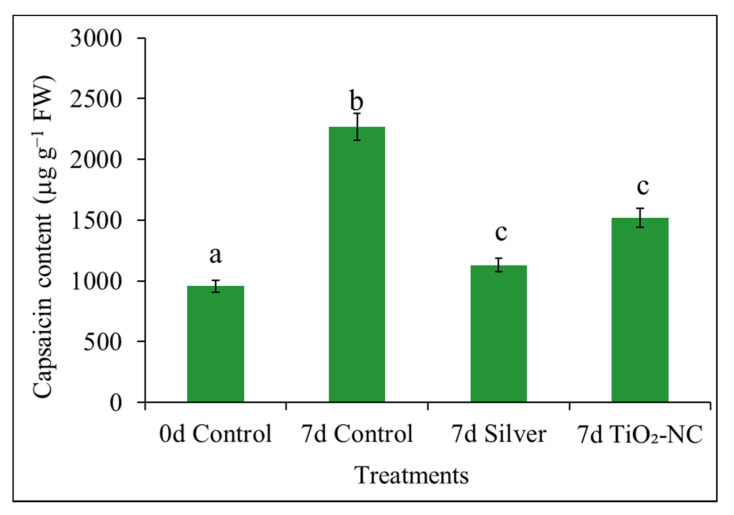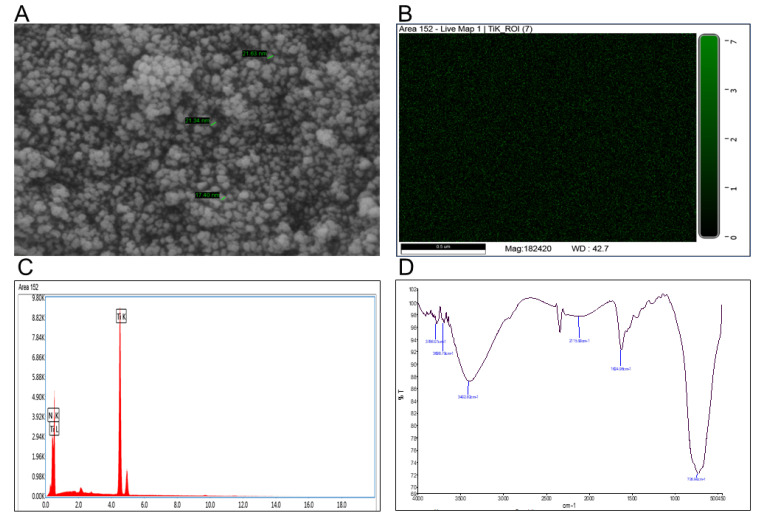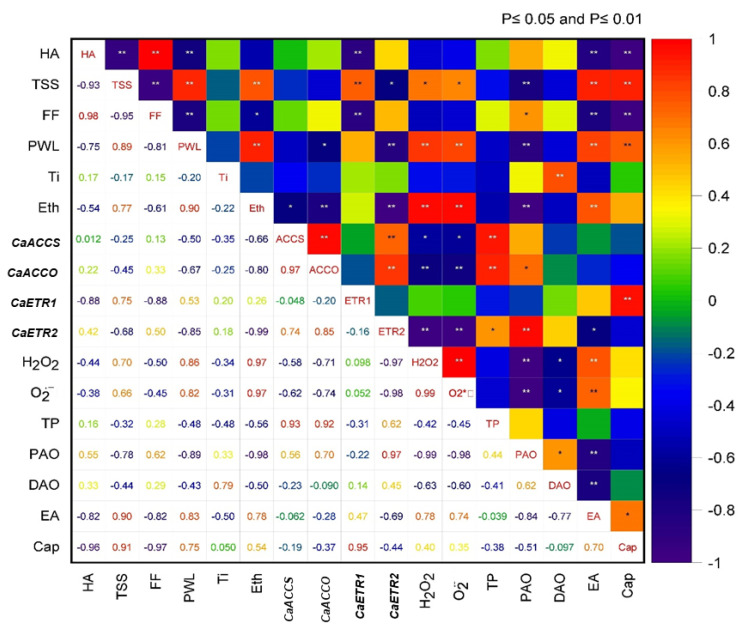Abstract
Capsicum is one of the most perishable fruit which undergo rapid loss of commercial value during postharvest storage. In this experiment our aim is to evaluate the effect of photoactivated TiO2 nano-particle complexed with chitosan or TiO2-nanocomposite (TiO2-NC) on extension self-life of Capsicum fruit and its effect on related morphological, physiological and molecular attributes at room temperature (25 °C). Initially, TiO2-NC coated fruits recorded superior maintenance of total soluble solids accumulation along with retention of firmness, cellular integrity, hydration, color etc. On the extended period of storage, fruit recorded a lower bioaccumulation of TiO2 in comparison to metallic silver over the control. On the level of gene expression for ethylene biosynthetic and signaling the TiO2-NC had more regulation, however, discretely to moderate the ripening. Thus, ACC synthase and oxidase recorded a significantly better downregulation as studied from fruit pulp under TiO2-NC than silver. On the signaling path, the transcripts for CaETR1 and CaETR2 were less abundant in fruit under both the treatment when studied against control for 7 d. The reactive oxygen species (ROS) was also correlated to retard the oxidative lysis of polyamine oxidation by diamine and polyamine oxidase activity. The gene expression for hydrolytic activity as non-specific esterase had corroborated the development of essential oil constituents with few of those recorded in significant abundance. Therefore, TiO2-NC would be reliable to induce those metabolites modulating ripening behavior in favor of delayed ripening. From gas chromatography-mass spectrometry (GC-MS) analysis profile of all tested essential oil constituents suggesting positive impact of TiO2-NC on shelf-life extension of Capsicum fruit. Our results indicated the potentiality of TiO2-NC in postharvest storage those may connect ethylene signaling and ROS metabolism in suppression of specific ripening attributes.
Keywords: ethylene, elicitors, fruit ripening, ACC synthase/oxidase, GC-MS, polyamines
1. Introduction
Fruit ripening is a unique process in plant biology where differential gene expression leads to a set of cellular and biochemical events, mostly catabolic in nature. Those are regulated throughout the ripening period with some metabolic fluxes under coverage of growth regulators such as auxin, ethylene (ET), gibberellin, abscisic acid and kinetins [1]. Ethylene, the key hormone is responsible for respiratory burst accompanying other cellular changes hastening the ripening of fleshy fruit. The changes during ripening essentially include hydrolysis of storage polysaccharides, turnover of proteins, conversion of pigments, de-acidification into organic acids, hydrolysis of esters leading to softening of pulp tissues [2]. Regardless of climacteric and non-climacteric types ET evokes several signaling cascades for fruit senescence through gene expression. Mostly those govern catabolic processes of biomolecules which may expedite ripening within postharvest storage [3,4]. Therefore, ET-mediated cellular reactions have principally been in quest for identification of specific gene(s) to alter metabolic functions for enhanced shelf life [5]. Likewise, key biosynthetic genes, viz. ACC synthase and ACC oxidase are targeted by synthetic residues to inhibit their activity to reduce postharvest losses. The metallic silver (Ag) has been a choice for biosynthesis and functional inhibition for ET activities [6]. At the cellular level, ET mediated signaling in ripening fruit are also blocked the ET receptors: ETR1, EIN3, CTR1, etc. In downstream of ET signaling identification of specific transcription factors (AP2/ERF) to their corresponding cis-elements is another point of approach for delayed senescence/ripening under storage [7]. Ethylene regulated such genes are diverse, still, principally falls under wall hydrolyzing/depolymerization (softening of texture), sugar-acid interconversion (changes in taste), secondary metabolite turnover (for aroma) related genes. In the background of ET sensitivity, the climacteric and non-climacteric types are characteristically differed with the presence or absence of auto-catalytic ET generation [8]. Moreover, the regulation of ET also governs the changes of metabolic flux that correspondingly contribute to the sensory character of ripening. Despite this, in postharvest biology, exogenous application of ET might be aligned to several cellular responses for softening of non-climacteric fruit also [9]. The major focus has been paid on cell wall depolymerization, ET generation and pigment biosynthetic enzymes as responsive genes were identified from non-climacteric fruit such as pepper [10].
The commercial practices to retard the postharvest softening are materialized by regulation of the ripening specific pathways. Ethylene would be the key one in a system to avoid direct exposure to fruit or minimization ET induced ripening phenomenon in the tissues [11]. Many approaches are established to down regulate ripening of the fruit by synthetic inhibitors, action inhibitors of ET such as 1-amino vinyl glycine, Ag+ ion, respectively, are the most common. The other physical and chemical treatments through oxidation, decomposition and adsorption of gas are not bio-compatible for the corrosive nature of chemicals used [12,13]. The adsorption technologies with activated carbon in various forms as powder/granular, fibers, zeolite, silica gel, electron-deficient based compounds such as dienes and trienes are very time consuming as well as complicated device-based in application [14]. So, any system qualified for ET scavenging if proves non-toxic, less absorbing, biocompatible for fruit quality must be in pursuit for postharvest storage. In the modern state-of-art the exercise of nanocomposite with metallics is important to scavenge ET by complete oxidation [15]. In an application of TiO2-NP under UV radiation observed a significant removal of gas in in vitro system. This metal oxide produces superoxide and hydroxyl radicals and other reactive oxygen species (ROS) under UV excitation on its nano-surface. The produced ROS is more effective to oxidize ET into CO2, H2O, regardless of room/low temperature, high humidity and no other specific environments. It is also noteworthy that TiO2 within nano ranges varies ROS generation with surface bridging OH•. Moreover, there recorded an intrinsic correlation for ROS activation under UV illumination for TiO2 nanocomposite with oxidation of ET [16]. So, ROS generation and its involvement in the ripening process is expected to be modulated by TiO2 in nano forms.
Many investigations have been carried out on effect of bulk TiO2 as well as TiO2-NC on postharvest shelf life of fruit such as mango, tomato, cucumber etc. [17,18]. On the other hand, chitosan/TiO2-NP composite also can effectively protect grapes from fruit rotting micro-organism [19]. Although TiO2-NC have been used studies in various fruit and vegetable, there is almost no data regarding its effect on quality of Capsicum fruit during postharvest storage.
In this paper, we focused on effects of TiO2-NC coating on quality indices, physiochemical properties and molecular characteristics of Capsicum fruit during postharvest storage at 25 °C for 7 d. In this investigation, we have evaluated the effectivity of TiO2-NC for ROS generation, polyamine metabolism, wall loosening enzyme, volatile substances and gene expression for ET metabolism on delayed ripening during postharvest storage.
2. Materials and Methods
2.1. Plant Material and Treatments
Chilli or Capsicum fruits of Tejaswani cultivar were brought in mature green stage from a local agricultural farm, then checked for any deformity, infection, damage and disinfected with 1% sodium hypochlorite solution followed by a repeated wash with deionized water. Treatment sets for the fruits are as follows: control (treated with distilled water), treated with 2 mg mL−1 silver solution (silver), coated with 1% chitosan solution containing 10 g L−1 TiO2-nanoparticle or TiO2 nanocomposite (TiO2-NC). Samples were kept inside separate quartz bottles equipped with airtight cap containing rubber septa with 3 replicates per treatment and 30 fruits in each replicate. All the beakers are kept under UV-A (365 nm) led light for 7 d at 25 °C. Sampling was carried out after 7 d taking at least three replicates per treatment and stored in −80 °C for further analysis. All results are expressed on fresh weight (FW) basis.
2.2. Study of Fruit Surface Morphology through Scanning Electron Microscopy (SEM)
Fresh samples from each treatment were cut into manageable pieces followed by dehydration through critical point drying method with K850 (Quarum Technologies, Switzerland). After drying samples were placed on metallic stubs and coated with 30 nm thick gold with plasma sputter coater (MNT-JS1600, MNT, Canada). Finally, surface morphology of the coated samples was analyzed through SEM (GeminiSEM 450, Zeiss, Oberkochen, Germany) according to [20].
2.3. Quality Parameters
2.3.1. Firmness of Fruit Coat
The firmness of fruit coat was measured by handheld penetrometer (GY-1, Wenzhou Tripod Instrument Manufacturing Ltd., China) with 8 mm wide stainless-steel plunger and measurements were carried out at 3 different points on fruit surface opposite to each other and the average value was expressed in N.
2.3.2. Color of Fruit Coat
Fruit from each treatment 3 replicates were taken and the color of each fruit at 3 different points was measured by chroma meter (CR-400, Konica Minolta, Osaka, Japan). The color was reported as hue angle (°).
2.3.3. Percentage of Water Loss
This was measured in gravimetric method comparing total water content (difference of weight of the fruit before and after drying in hot air oven at 50 °C for 48 h) and the difference in weight of fruit at initial day and after 7 d of treatment taking 3 replicates from each treatment according to Scalisi and O’Connell [21].
2.3.4. Total Soluble Solid Content
Five g of fruit from each replicate was taken, and fruit juice was extracted from pericarp region by pressing. The total soluble solid content was measured using refractometer (RHB-32ATC MCP, Japan) by putting a few drops of fruit juice on the detection surface.
2.3.5. Quantification of Ti in Fruit
One g of fruit pericarp was digested with 10 mL tri acid mixture (H2SO4:HNO3:HClO4 = 3:3:1) and cooled. After cooling the concentrated acid mixture was diluted in 90 mL of ddH2O and Ti content was measured with ICP-MS (Agilent 7800, Agilent Technologies Inc., Santa Clara, CA, USA) against known standard according to Ghosh et al. [6].
2.4. Ethylene Measurement
One mL of gas sample from each replicate were drawn using as GC syringe from the head space of each vail containing rubber septum and the ET was quantified with a flame ionization detector gas chromatograph (GC-8A, Shimadzu, Japan) equipped with an active aluminum column T.R. Ethylene content was expressed in nM kg−1 s−1.
2.5. Preparation of RNA
One g of fresh pericarp tissue of fruit was frozen with liquid nitrogen and frozen tissue was crushed to powder with mortar and pastel. RNA was isolated from about 50 mg frozen powdered tissue using trizol (Trizin, GCC Biotech, West Bengal, India) RNA extraction method according to the manufacturer’s protocol. For removal genomic DNA isolated RNA was digested with DNase I (Qiagen) according to manufacturer’s instructions. Quantification of RNA was carried out by nano-drop spectrophotometer (Thermo Fisher Scientific, Wilmington, NC, USA) and integrity RNA samples were analyzed by electrophoresis in 1.5% agarose gel.
2.6. Semi-Quantitative PCR
For semi-quantitative PCR analysis, total RNA samples were reverse transcribed into cDNA using cDNA synthesis kit (GCC Biotech, India) following the manufacturer’s protocol in triplicate. cDNA samples are amplified by step one PCR system using PCR master mix (GCC Biotech, India) with specific primers. Gene-specific primer for ACCS, ACCO, ETR1, ETR2 and GAPDH used according to [22] where GPDH gene used as control. The temperature for the PCR reaction was: initial denaturation 95 °C for 5 min, 35 × (denaturation at 95 °C 30 s, annealing at 55 °C for 30 s and extension at 72 °C for 30 s), final extension at 72 °C for 5 min. 2 uL of PCR product from each sample was run in 2% agarose gel and photographed for using Gel Doc system. Densitometry scanning was carried out using GelAnalyzer 19.1 (www.gelanalyzer.com, accessed on 11 December 2022 ) software.
2.7. Quantification of ROS
2.7.1. Quantification of H2O2
One g of the sample from each treatment were crushed 0.01 M phosphate buffer (pH 7.0). After that the homogenate is centrifuged at 12,000× g for 15 min and obtained supernatant was mixed with chromate reagent [19]. The mixture was then kept inside a boiling water bath until the development of greenish color and quantification of H2O2 was carried out spectrophotometrically at 570 nm according to Ghosh et al. [23]. The result was expressed as µmol g−1 FW.
2.7.2. O2•− Content
For detection of O2•− fresh samples were thoroughly crushed in a 65 mM phosphate buffer pH 6.5. The homogenate was centrifuged at 12,000× g for 15 min at 4 °C and obtained supernatant was mixed with 65 mM phosphate buffer pH 7.8. The diluted supernatant was then mixed with 10 mM hydroxylamine hydrochloride and incubated 30 min at 25 °C. After that 7 mM alfa-napthylamine and 10 mM sulfanilamide were added and kept at 37 °C for 20 min. From mixture O2•– was quantified according to Ghosh et al. [23].
2.8. Quantification of Total Capsaicin Content
In this case, 500 mg of dried fruits from each replicate crushed into fine powder and extracted with 10 mL of acetone for 5 h. Then all samples centrifuged at 10,000× g and supernatant collected. 4 mL of supernatant for each sample were taken into separate test tube and the capsaicin content was determined at 660 nm according to Sadasivam and Manickam [24]. Capsaicin content is expressed in µg capsaicin g−1 dry weight (µg g−1 DW).
2.9. Quantification of Polyamine and TLC Separation
500 mg of fruit tissue was crushed in 10% perchloric acid and homogenates were reacted with dansylchloride and run through silica TLC plate and quantified according to Wettlaufer and Weinstein [25].
2.10. Enzyme Activity Assay
2.10.1. Esterase (EC 3.1.1.1) Activity
One g of fruit pericarp tissues was frozen in liquid N2 and ground into fine powder. From the powdered tissue, esterase activity was measured according to Kumar et al. [26].
2.10.2. Polyamine Oxidase Activity and Diamine Oxidase Activity
Fruit samples were frozen with liquid N2 and crushed into powder for enzyme extraction. The enzyme extraction and activity were determined for polyamine oxidase activity (PAO; EC 1.5.3.11) and diamine oxidase activity (DAO; 1.4.3.22) according to Moschou (2018), respectively.
2.11. Extraction of Essential Oil
Fifty grams of fruit from each treatment including control were chopped into manageable pieces and gone through hydro distillation by clevenger type apparatus [27]. Then essential oil was extracted by dichloromethane (DCM) and condensed with a rotatory evaporator. Before GC MS analysis DCM fraction of essential oil was dehydrated over anhydrous sodium sulphate.
2.12. GC-MS Analysis of Essential Oil
GC-MS analysis was carried out using Agilent 7000 (Agilent Technologies Inc., Cheadle, UK) and compounds were separated using Agilent 122-5532 DB–5MS column. Helium was used as a carrier gas with a flow rate of 1 mL min−1 and injection volume was 2 µL and slit injection was used with ratio of 10:1. The inlet temperature was 250 °C and the ion source temperature 230 °C. Total run time was 60 min and the range of mass scanned was 50 to 550 amu GC-MS data were analyzed with Chem-Station (Agilent Technologies Inc., Cheadle, UK) following identification of compounds from retention index and custom mass spectra with NIST, 2014 library. Retention indices were calculated using n-alkane series C7 to C40 under sample operating parameter. Experiment was carried out with two replicates.
2.13. Characterization of TiO2-NP
The morphology, size and atomic composition of TiO2-NP was determined by SEM (GeminiSEM 450, Zeiss, Oberkochen, Germany) equipped with Energy Dispersive X-ray (EDX) module according to Femi-Adepoju et al. [28]. Determination of functional group was carried out Fourier transform infrared spectroscopy (FTIR, Agilent Cary 630, Agilent Technologies India Pvt Ltd, Delhi, India) analysis with spectral scan od 450–4000 cm−1 at a resolution of 4 cm−1 [29].
2.14. Statistical Analysis
All the acquired data were analyzed by Student’s t-test (SPSS, IBM, Armonk, New York, NY, USA) for analysis of the difference between treatments. The statistically significant differences were considered at p ≤ 0.05. The obtained data were presented at mean ± standard error (SE). The correlation figure was created through software.
3. Results
3.1. Firmness, Color, Turgidity and Total Soluble Solids of Fruit on TiO2-NC Treatment
Developmental changes in fruit 7 d of ripening period under storage recorded significant morphological variations (Figure 1). The changes in color, texture, fruit coat firmness was notably affected with treatments such as silver or TiO2-NC (Figure 2). The surface morphology as critically analyzed by SEM studies for fruit coat which recorded a distinct variation through the treatments (Figure 1). Interestingly, the surface was significantly affected with 7 d on postharvest storage indicating the changes through ripening activities including loss of water. This pledges a possible relationship with other qualitative characters for ripening on fruit. This exclusively shows distinct crack and crevices on the cell wall that might ooze out cell sap and odor as a mark of ripening, however, in general. This feature was almost erased when fruit were observed from either silver or TiO2-NC, still maximum for the latter. Remarkably, the changes on cell surface nearly exist in parallel with variations in fruit color through the days of storage. Therefore, a possibility may arise on recovery of any cellular lysis of fruit coat being quite usual as usual for ripening under the aid of TiO2-NC.
Figure 1.
Changes in morphology and changes in fruit coat surface as revealed through scanning electron micrograph (SEM) in Capsicum fruit. The SEM images revealed the microscopic cracks and crevices on fruit coat surfaces and their variations on 7 d (B) postharvest storage over 0 d control (A). The 7d silver (C) and 7d TiO2-NC treatments (D) had their respective impacts on the possible repair of cell wall lysis.
Figure 2.
Hue angle (A), fruit firmness (B), percentage of water loss (C) and total soluble solid (D) of Capsicum fruit recorded under silver and TiO2-NC with respect to control during 0 d and 7 d of postharvest storage at 25 °C. Vertical bars showing SE± 1 (n = 3) on each column and letters above bars indicate statistical variations between treatments based on One Way ANOVA (p ≤ 0.05).
The changes in fruit color as measured by hue angle had significant variation under both treatments (Silver and TiO2-NC) compared to control at 7 d of storage. Both silver and TiO2-NC maintained the color with only 4 and 12% decrease in hue angle compared to 72% in 7 d control over control at 0 d (Figure 2A). The firmness of fruit in the pressure unit (N) reveals the integrity of Capsicum fruit coat when observed under different treatments. A significant (p ≤ 0.05) reduction by 76% was recorded from fruit on 7th d of storage as compared to the initial day (Figure 2B). Interestingly, silver and TiO2-NC maintained firmness with only 13 and 20% reduction with respect to control at 0 d. The individual interaction of silver and TiO2-NC showed no significant (p ≤ 0.05) variations infirmness of fruit at 7 d.
With the duration of storage time fruit also observed gradual dehydration or loss of seeming freshness. This was documented with the percentage of water loss by gravimetric method and maximum loss of water was recorded in 7 d control by 15% compared to 0 d control (Figure 2C). Whereas, both silver and TiO2-NC had proportionately reduced water loss by 50 and 100%, respectively, over control at 7 d. On the other hand, fruit accumulated soluble solid that varied significantly through the treatments. (Figure 2D). The maximum amount of TSS was recorded in 7 d control which accounts 76% increase over 7 d silver. The treatment such as silver and TiO2-NC significantly (p ≤ 0.05) reduced TSS accumulation in respective to 7 d control. Still, TiO2-NC had reduced the content by 47% over control (7 d) and thus suggested more effectiveness in delayed ripening with a negative correlation value (r = −0.97) with the firmness of the fruit coat.
3.2. Absorption of Ti and Release of Ethylene from Fruit Tissues
The biosorption of the Ti within the fruit tissues was interesting when observed after 7 d of TiO2-NC treatment compared to control (untreated). In one of those groups treated (TiO2-NC) fruit, metal content was directly measured (Ti) without any washing and these samples recorded 4.17 mg kg−1 DW which was only 0.14 mg kg−1 DW in untreated control (Figure 3). In another group, samples were thoroughly washed, dried and measured the metal content show a significantly (p ≤ 0.05) lower values, an almost negligible increase of 0.22 mg kg−1 DW over control. Thus, as on a comparative basis, it accounted for 91% reduction of Ti over TiO2-NC before washing. This implies a significant low absorbing trend of Ti within the fruit tissues when applied with chitosan amalgamation as TiO2-NC. Therefore, the application of TiO2-NC may involve the phenomenon of biosorption of metal rather than bioaccumulation which may have entered into the fruit tissue through opening present is pedicel region of fruit. This may recommend TiO2-NC would be a safe residue to be applied as a postharvest preservative for its non-invasive nature.
Figure 3.
Absorption of Ti in Capsicum fruit recorded from 7 d TiO2-NC treatment and 7 d TiO2-NC washed with respect to control on 7 d storage under 25 °C. Vertical bars showing SE ± 1 (n = 3) on each column and letters above bars indicate statistical variations between treatments based on one way ANOVA (p ≤ 0.05).
Endogenous ET in the fruit tissues was recorded in varying concentrations from different treatments. Thus, control fruit at 7 d recorded significant upregulation of ET generation against 0 d control and measured 5.4 nmol kg−1 s−1 compared to 0 d control 2.1 nmol kg−1 s−1 (Figure 4). The treatments such as silver or TiO2-NC had significant variations in ET content as expected over the control. So, the release of endogenous ET was maximized under silver treatment with 83% increase from 7 d TiO2-NC but not with significant variation against 7 d control (Figure 4). On the contrary, the ET content was downregulated by 36% under the same condition when fruit were treated with TiO2-NC (Figure 4). The changes in ET concentration were significantly impacted on quality characters TSS (r = 0.75), firmness (r = −0.62), hue angle (r = −0.54) with as evident from the correlation matrix (Supplementary Materials Table S1).
Figure 4.
Changes in ET evolution of Capsicum fruit under silver and TiO2-NC with respect to control during 0 d and 7 d of postharvest storage at 25 °C. Vertical bars showing SE ± 1 (n = 3) on each column and letters above bars indicate statistical variations between treatments based on one way ANOVA (p ≤ 0.05).
3.3. Expression of Genes for Ethylene Biosynthesis and Signaling
Expression levels of the targeted homologs for transcripts for ET biosynthesis and signaling genes, viz., CaACC synthase, CaACC oxidase and CaETR1 and CaETR2 were checked. Through the semi-quantitative RT-PCR technique, the transcripts were evaluated against CaGAPDH (as internal control) and those revealed about downregulation for ACC synthase under TiO2-NC against 0 d control. During storage of 7 d, the expression changed under the same treatment which was significantly (p ≤ 0.05) higher than silver (Figure 5). Meanwhile, silver had changed the expression of a gene compared to respective 0 and 7 d control. For conversion of ACC to ET the gene involved as CaACC oxidase had inclined a similar pattern of expression. However, for both the treatments such as silver and TiO2-NC expression was more pronounced by distinct suppression respective genes (Figure 5). Contrarily, signaling pathways of ET governed by different genes: CaETR1 and CaETR2 had distinct variations in expression under treatment concerned. Interestingly, for ETR1 expression was quite abundant by transcript densities of 7 d control less than TiO2-NC under same duration (Figure 5). Thereafter, the variations were more pronounced by 25% downregulation under silver and upregulation under TiO2-NC over the 0 d control. For other genes such as CaETR2, the relative expression recorded a steady fall from ongoing days of storage under 7 d control (Figure 5). Interestingly, TiO2-NC had retrieved the expression of CaETR2 as compared to silver. Still, silver was not able to upregulate ETR2 as TiO2-NC rather subdued the expression on completion of storage i.e., after 7 d.
Figure 5.
Expression of CaACCS, CaACCO, CaETR1, CaETR2 genes as compared to CaGAPDH as control gene in Capsicum fruit under silver and TiO2-NC with respect to control during 0 d and 7 d of postharvest storage at 25 °C.
3.4. Accumulation of ROS (H2O2 and O2•−) in Fruit Tissues under Storage
H2O2 and O2•− followed almost a similar pattern in control and treatments up to the completion of the storage period. In the case of H2O2, the maximum accumulation occurred (17% over 7 d control) in fruit tissue when observed from silver treatment. Conversely, TiO2-NC reduced the content on 7 d storage which recorded 63% less than 7 d control (Figure 6A). TiO2-NC had suppressed O2•− accumulation by 69% over the silver under the same condition (Figure 6B). Fruit proceeding through storage period recorded 0.67 µmol g−1 increase in O2•− content, however, under control condition. Furthermore, treatments such as silver had the impact on ripening to accumulate O2•− by 0.87 µmol g−1 over 0 d control. On the contrary, TiO2-NC rather reduced the ROS (O2•−) significantly (p ≤ 0.05) by 53% in contrast with silver as compared to 7 d control.
Figure 6.
H2O2 content (A) and O2•− content (B) of Capsicum fruit recorded under silver and TiO2-NC with respect to control during 0 d and 7 d of postharvest storage at 25 °C. Vertical bars showing SE ± 1 (n = 3) on each column and letters (a, b, c and d) above bars indicate statistical variations between treatments based on one way ANOVA (p ≤ 0.05).
3.5. Catabolism of Polyamine during Ripening on Storage
Ripening of fruit with many physiological effects by ET intervention are antagonized by polyamines. As Figure 7 shows the total polyamine content gradually decreased during the ongoing storage period. This decrease was maximum at TiO2-NC which shows 27% decrease with respect to 0 d control at 7 d. Increased polyamine often supports fruit firmness, redox maintenance, sugar metabolism those all for the prevention of ripening. Therefore, turnover of polyamines is likely to be hastening the fruit senescence, specifically through ROS generation under storage conditions.
Figure 7.
Separation and identification of total polyamine from Capsicum fruit on TLC plate and resolved under UV illumination under silver and TiO2-NC with respect to control during 0 d and 7 d of postharvest storage at 25 °C. Vertical bars showing SE ± 1 (n = 3) on each column and letters above bars indicate statistical variations between treatments based on one way ANOVA (p ≤ 0.05).
On this notion, we checked the catabolism of polyamines by enzymatic lysis with polyamine oxidase activities. This is more to predict the correlation (p ≤ 0.05, r = −0.99) of ROS (H2O2) generated by polyamine oxidation and its contribution to the peroxidation of fruit. Thus, the activity of DAO enzyme had the downregulation through 7 d storage, however, under control by 11% over the initial (Figure 8B). Treatment such as silver or TiO2-NC had their respective effects on DAO activity. Thus, under silver treatment, the subdued activity recorded 11% less over control whereas, it was upregulated by 33% for TiO2-NC (Figure 8B). An almost similar or compatible trend was noticed for PAO also where fruit attained a peak activity at 0 d control. Two treatments such as silver and TiO2-NC were more capable to minimize the activities of the enzymes where 64 and 14% fall in values over the 0 d control were recorded during storage (Figure 8A). Although PAO activity is higher in TiO2-NC with respect to other treatments at 7 d, lower polyamine content in fruit tissue may have minimized its impact on fruit ripening.
Figure 8.
Activity of PAO (A), DAO (B) from pulp tissues of Capsicum on tissues under silver and TiO2-NC treatments with respect to control (0 d) and 7 d storage of postharvest at 25 °C. Vertical bars showing SE ± 1 (n = 3) on each column and letters (a, b, c and d) above bars indicate statistical variations between treatments based on one way ANOVA (p ≤ 0.05).
3.6. Esterase Activity and Its Polymorphic Expression on Fruit Softness
Changes in the functioning of various cell-wall bound or cytosolic hydrolases including esterases are important in fruit softening. Ongoing days of postharvest storage Capsicum fruit recorded a distinct variation of esterase activity in 7 d silver and 7 d TiO2-NC treated fruits with respect to 7 d control. From the initial (0 d) period of ripening fruit showed a sharp rise of esterase activity by 10 units reaching at 7 d, however, at control. Still, on the activity of silver and TiO2-NC the activity of esterase reduced by 56 and 96% over control (Figure 9). Interestingly, the activity of esterase under those treatments had an impact on fruit firmness with a significant (p ≤ 0.05) effect as reading correlation matrix. The influence of TiO2-NC for its altered activity had also been accompanied by polymorphic expression of esterase at the gene level. Thus, esterase profile may set as a possible biomarker as Capsicum fruit attained the delayed ripening under silver or TiO2-NC.
Figure 9.
Activity of esterase from pulp tissues of Capsicum on tissues under silver and TiO2-NC treatments with respect to control (0 d) and 7 d storage of postharvest at 25 °C. Vertical bars showing SE ± 1 (n = 3) on each column and letters above bars indicate statistical variations between treatments based on one way ANOVA (p ≤ 0.05).
3.7. Changes in Essential Oil Contributing Major Metabolites in Ripening
The major metabolites were separated, resolved their identification and relative concentration were determined with GC-MS studies. From overall 52 identified metabolites, it was only 13 had significant up/downregulation in the content through the storage period which includes alkane, ester, fatty acid and alcohol etc. (Table 1). It is quite clear from the Figure 10 constituents of essential oil follow a pattern which indicated ongoing ripening process. On specific constituent of essential oil such as C1 (Cuben-11-ol), C2 (Spiroether) and C6 (1,3-dihydroxypropane-2-ylhexadecanoate) it exhibited sharp decrease concentration by 30, 12 and 0.4% at 7 d storage, whereas, it is only 16, 6 and 0.13%, respectively, under influence of TiO2-NC over the 0 d control (Figure 10). Contrarily, alkanes such as C9 (Heptacosane), C11(Triacontane), C12 (Hentriacontane) recorded significant increase at 7 d control by 10, 7 and 3.21%, respectively over 0 d control. On the other hand, TiO2-NC treatment recoded just 44 and 21% increase C9, C11, respectively, and C12 decrease by 0.09% compared to control (Table 1).
Table 1.
Major composition of essential oil in C. annuum fruit under various treatments.
| No. | Name of Compound | Calculated KI | Reported KI | Concentration (%) | ||
|---|---|---|---|---|---|---|
| 0 d Control | 7 d Control | TiO2-NC | ||||
| C1 | Cuben-11-ol | 1595 | 1595 | 34.02 | 4.12 | 17.66 |
| C2 | Spiroether | 1880 | 1879 | 14.22 | 1.78 | 7.94 |
| C3 | 1,3-dihydroxypropan-2-ylhexadecanoate | 2289 | 2289 | 3.15 | 2.79 | 3.02 |
| C4 | Methyl labdanolate | 2382 | 2381 | 2.83 | 9.36 | 9.11 |
| C5 | Tetracosane | 2388 | 2400 | 4.67 | 5.39 | 5.40 |
| C6 | Pentacosane | 2488 | 2500 | 4.74 | 8.32 | 4.88 |
| C7 | Hexacosane | 2588 | 2600 | 4.36 | 11.30 | 5.50 |
| C8 | Nonacosanoicacid | 2673 | 2674 | 3.95 | 3.08 | 5.65 |
| C9 | Heptacosane | 2745 | 2700 | 3.41 | 13.79 | 4.90 |
| C10 | Pentatriacontane-2-one | 2873 | 2873 | 2.85 | 0.40 | 4.31 |
| C11 | Triacontane | 2985 | 3000 | 2.50 | 9.31 | 3.10 |
| C12 | Hentriacontane | 3084 | 3100 | 2.55 | 6.26 | 2.46 |
| C13 | Dotriacontane | 3183 | 3200 | 1.84 | 4.02 | 2.02 |
| Total percentage | 85.10 | 79.93 | 75.94 | |||
Figure 10.
Radar plot showing the pattern of changes in concentration of major constituents of essential oil under TiO2-NC treatments with respect to control at 0 d and 7 d storage of postharvest at 25 °C.
3.8. Capsaicin Content
Capsaicin content was quantified spectrophotometrically which is main contributing factor for pungency. It has been observed that capsaicin content increase as the fruit ripening during storage (Figure 11). Likewise, capsaicin content increased by 1312 µg kg−1 at 7 d control with over 0 d control. On the other hand, capsaicin content of 7 d silver and 7 d TiO2-NC increase by 15 and 59% over control at initial day. Changes in the capsaicin content showed positive correlation with ET content and negative strong correlation with hue angle and firmness of fruit.
Figure 11.
Capsaicin content of Capsicum fruit recorded under silver and TiO2-NC with respect to control during 0 d and 7 d of postharvest storage at 25 °C. Vertical bars showing SE ± 1 (n = 3) on each column and letters above bars indicate statistical variations between treatments based on one way ANOVA (p ≤ 0.05).
3.9. TiO2-NP and Its Opto-Physico-Chemical Characterizations
As described earlier molecular nature of TiO2-NP was confirmed by different physico-optical properties. This assumed the uniform sizes of particles as bearing conformity with earlier description [29]. Preliminarily, FE-SEM study was carried out for the shape and size of nanomaterial. This revealed diameter of NP ranges between 15–30 nm which was within the limit of ≤100 nm size as resolved in SEM image and appeared spherical to the globular unit (Figure 12A). From the SEM EDAX the presence of Ti in the NP has been verified which is represented as green dots in Figure 12B and it also shows a sharp pick of Ti in Figure 12C which confirms the presence of Ti in NP. The FTIR spectroscopy finally revealed the associated bond energy changes (cm−1) from projected varying functional groups of TiO2-NP (Figure 12D) [30]. Largest pick was observed at 726.96 cm−1 along with another small pick at 482 cm−1 which confirms presence of characteristic O-Ti-O bond in TiO2-NP. Other picks at 3402.82 cm−1 and 1624.96 cm−1 indicated surface absorbed water and hydroxyl bonds, respectively (Figure 12D).
Figure 12.
SEM image showing size dstribution of TiO2-NPs (A), EDAX map TiO2-NPs to confirmtion the presence of Ti (B), quantification of Ti by EDAX in the TiO2-NP (C) and FTIR showing distribution of different bonds present in TiO2-NPs (D).
3.10. Correlation among the Parameters
From the Pearson’s correlation matrix, it comes in a note that physiological and cellular attributes in ripening are quite variable in contribution and more in a complex manner. Ripening of Capsicum fruit involves oxidative reactions, so ROS metabolism influencing ripening specific traits found significant, however, variably regulated under different treatment. Thus, initially changes in ROS (H2O2 and O2•−) related positively with ripening parameters such as TSS but negatively with firmness. Similarly, total polyamine content had a significant (p ≤ 0.05) negative correlation with ROS (Figure 13). The ROS-producing activity polyamine oxidation had a variable influence on ripening. Thus, DAO and PAO had an indirect contribution with ROS by the generation of H2O2 but not with others. On the other hand, ET accumulation with ACC synthase and oxidase had their respective values but not always directly contributed to ripening characters such as TSS, color, firmness etc. Contrarily, ET receptors, specifically ETR2 had regulated negatively the ET accumulation thereby showing an indirect feedback on ripening. Moreover, signaling through ETR2 had impacted in suppression of ROS such as both O2•− and H2O2 content as observed through negative correlation values (Figure 13). So, ROS intervention in ripening phenomena is not simple but complex and discriminatorily in collusion with related physiological characters.
Figure 13.
Correlation matrix heatmap of significant attributes in modulation ripening process under treatments. Here, lower triangle represents correlation values and upper triangle represents the significance levels (* and ** represent significance level at p ≤ 0.05 and p ≤ 0.01, respectively) between different parameters. HA-Color in hue angle, TSS-Total Soluble Solid Content, FF-Firmness of fruit coat, PWL-Percentage of water loss, Ti-Titanium accumulation, Eth-Ethelene content, ACCS-expression of ACC Synthase, ACCO-Expression of ACC oxidase, ETR1-Expression of ETR1, ETR2-expression of ETR2, H2O2-Hydrogen peroxide content, O2•−-superoxide content, TP-Total Polyamine Content, PAO-Activity of PAO, DAO-Activity of DAO, EA-Activity of Esterase, Cap-Capsaicin content.
4. Discussion
4.1. Modulation of Quality Characters for Ripening under TiO2 Nanocomposite
Nanoparticles of titanium (TiO2-NPs) are less frequent in use but focus exclusively on their photocatalytic properties. Thus, TiO2-NPs in plants are exercised as a photocatalytic agent for ET with strong reducing activity under UV irradiation [31,32]. In postharvest storage of fruit and vegetables, the application of such an ET scavenger is thus entrusted more with its non-toxicity as well as less invasiveness within the fruit coats [33]. This have got evident in our experiment when Capsicum recorded a less bioaccumulation of Ti in the fruit pulp over the control. This is more realistic when we used the chitosan coating in the retention of hydration to support freshness during the storage of Capsicum fruit. Chitosan being semi-permeable in nature could modify the fruit tissue atmosphere, more specifically increasing hydration vis-a-vis regulating transpiration loss [23]. This makes it prudent for ET and its role in initiation, modulation and coordination of gene expression related to ripening. Therefore, initially for sensory characters such as color, firmness, relative water content etc. were more significantly bothered under treatment of TiO2-NP with chitosan (TiO2-NC) over silver treated samples. Stimulatingly, the experiment became optimistic in the delay of the ripening process when the TiO2-NC treatment sustained more firmness and color of the fruit through ongoing days of storage. This may be caused by combinational effect of chitosan (caused by inhibition of transpersonal loss of water and maintenance of fruit coat integrity) and TiO2-NP which reduce the ET accumulation by photocatalytic reductor process which cause delay in ET induced ripening responses such as turnover of pigments [34]. This assumes the possible suppression of ET in delaying of ripening process through other changes in the structural and functional integrity of fruit undergoing maturation. One of the most import characters of Capsicum is pungency which is mainly due to capsaicin, one of main metabolite in capsinoids family [35]. During postharvest storage capsaicin content becomes increased, which is an indication of progress of fruit ripening [36]. In this experiment TiO2-NC effectively decreased accumulation of capsaicin with respect to untreated control which is an indication of delayed ripening during postharvest storage. Interestingly, the TiO2-NC treatment was more lenient to maintain the fruit coat intactness as no significant rupture/scars were observed by SEM images as compared to silver-treated fruit. This ensures the acceptability of NC as ecofriendly chemical residues owing to non-invasive features. This is quite in agreement with previous cases where suppression of ET by 1-MCP had secured the firmness of fruit coat with a decrease in soluble solid content during storage [37]. The changes in soluble solid content are important for characterizing the ripening metabolism. Soluble solids cover heterogenous complex organic residues which in combination with titrable acidity make a reliable ripening index [38]. So, a decline or subdued of soluble solid concentration may serve the characteristics of delayed ripening. Thus, TiO2-NC would be reliable for maintaining the soluble solid throughout the postharvest circumvents the paths of retarded senescence. So, from the biosafety purpose Capsicum fruit in our experiment might acknowledge the efficacy of TiO2-NC in retention of firmness, color over refereed toxic of chemicals such as silver. Loss of water otherwise deducing the reduction of hydration or freshness of the fruit during postharvest storage had more success with TiO2-NC than silver. In general, chitosan, basically a cationic polymer of N-acetyl-d-glucosamine is served with an admirable film coating surface with hydrophilic activity. In addition to the hydrophilic activity of chitosan through semi-permeable film, it can control the tissue atmosphere decreasing the transpiration or vapor loss [19]. So, from fruit quality aspect application of chitosan with the combination of nanomaterial would be successful. Chitosan steeping with additional residues such as Ca2+ on fruit coat had impacted on key metabolites pool such as organic acid and its turn over governing moderation of shelf life in other fruit [39].
4.2. Transcript Dynamics of Ethylene Biosynthesis and Signaling Paths
Available information has emphasized the bioaccumulation of ET and its regulation is a key element for the moderation of postharvest ripening. Inhibitors such as 1-MCP not only played in the suppression of ET biosynthesis but also delay the fruit senescence through the accumulation of different antioxidants [40]. The latter in turn suppresses the membrane permeability as well as lipid peroxidation of the fruit coat. Herein also Capsicum fruit had significantly moderated under treatment of TiO2-NC as compared to standard ET action inhibitor such as metallic silver. The differential ET accumulation on storage is quite consistent for the expression of ripening specific genes such as CaACC synthase and CaACC oxidase [41]. This is quite satisfactory to receive a good regulation for both of those transcripts and their relative abundance under TiO2-NC. The transcriptional upregulation for ACC conversion would sensitize not only the ET accumulation but also induces gene cascade linked to other metabolites web. Therefore, ACC metabolism contributing ET moderation under any treatments would suffice the sustenance of greenness on storage where TiO2-NC might efficaciously qualify. ACC metabolic genes in nexus with anti-oxidation paths and their upregulation have maximum affinity when treated with blue LED irradiation as recoded in citrus [42]. This could be accounted in the present case when TiO2-NC with its s intrinsic property to be energized with UV irradiation which photocatalytic degrade ET. Inhibition of ET on the biosynthetic pool for delayed senescence a level of regulation exists with its downstream signaling for ripening genes. It is well agreed that ET signaling cascade is active in normal condition and binding of ET to its receptors facilitated autocatalytic degradation of certain regulatory elements of ET by feedback regulation. This contemplates for silver treatment is no longer with any inhibition for ET synthesis but may act as an inhibitor of the signaling pathway of ET sensitivity is based on activation of receptors such as ETR2 and EIN2 which at specific domain is occupied by silver in a competitive manner such as 1-MCP [41]. Ongoing days of ripening for Capsicum where TiO2-NC upregulated the transcriptional dynamics of ETR1 and ETR2 significantly over silver when compared to 0 d control. This establishes no regulation of TiO2-NC on action or functioning level besides exclusively for the subdued synthesis of ET by the compatible trend of ACC synthase and ACC oxidase expression. This is well consistent with the revealed fact from others’ studies in tomato, apple where treated fruit with 1-MCP had delayed the ripening both in terms of reduced ET biogenesis corresponding to the decrease in gene expression. However, non-inhibitory nature of TiO2-NC in ET signaling is otherwise advantageous over silver, however, in a different way. In fact, induction of CaETR1 and CaETR2 is otherwise involved for significant expression of related gene cascade of ET signaling. The latter includes the antioxidation-related gene in lysis of ROS; reduces peroxidation, carbonylation reactions and accelerates senescence, otherwise hastens ripening process. So, TiO2-NC may be more privileged over silver, 1-MCP such as conventional agents in the application for dual roles: to reduce the endogenous ET concentration and induce antioxidation activities to retards ripening in postharvest storage.
4.3. ROS Metabolism Is Related to Polyamine Oxidation in Progress of Fruit Ripening at Storage
Ripening being on penultimate stages of senescence characterized by hydrolysis and diverse peroxidative reactions on macromolecules with the generation of ROS [42]. It is with well evidential support that an active metabolism of ROS is involved in various species such as sweet pepper, tomato, guava, mango, grape etc. [43]. Consistently, the ROS metabolism and its antioxidation by nonenzymatic as well enzymatic paths characterize the changes in quality characters of fruit such as softening, color, odor. However, in-built antioxidation system or its improvisation by exogenous elicitors accommodated to regulate the ripening behavior within postharvest storage. Understanding the hastening of senescence by the advent of ROS fruit tissues in our experiment realized a significant moderation superoxide (O2•−), peroxide (H2O2) under TiO2-NC. ROS has its dual functionalities in ripening incident of fruit mostly with peroxidative lysis and activation of conserved ripening-related genes regardless of non-climacteric and climacteric types [44]. It is mostly the metabolism within mitochondrial energy-dependent paths and oxidation of few biomolecules connecting between ET production and respiratory during the ripening. The availability of ROS may also be circumvented by oxidation of residues polyamine being predominant. Polyamine, a ubiquitous polycationic straight-chain hydrocarbon residue with characteristics of few −NH2 functional groups with varied unsaturation exists in various cell fractions. This molecule undergoes protonated at biological pH and being nucleophilic in nature can bind most of the positively charged bioresidues in cells. This facilitates rendering a shielding effect from oxidation by ROS or free radicals under abiotic stress in plants [5]. In ripening fruit roles of polyamines are based on two facts: one, antagonizing the ET biosynthetic paths and shielding the biomolecules from peroxidative degradation by ROS developed from various catabolic reactions [45]. Polyamines use a common precursor (such as arginine) and biosynthetic paths with ET. This may be diverged depending on plants’ cellular demand from an intermediate such as ACC and directed either into polyamine or ET. Postharvest period triggering more ET biosynthesis than polyamine is obvious to expedite the fruit senescence. A consistent inverse interrelationship has been common in many cases between ET and polyamine metabolism in ripening fruit. Thereby, a depletion of polyamine on 7 d of storage in Capsicum fruit might link the increased activities of DAO and PAO under treatment of silver and TiO2-NC in favor of more ROS such as H2O2 [46]. H2O2, however, within a threshold concentration, in turn, be inductive of several antioxidation cascade-like activities of class III peroxidase to reduce the oxidative damages of fruit tissues and thereby impeding the ripening process.
4.4. Metabolites Profiling: The Abundance of Essential Oils Induced by Nanocomposite
The ripening is highly regulated by abundance of specific metabolites influencing quality characters. Instead of a single one metabolite collection of different metabolites have wide coverage through ripening period as well as proportionate contribution to agronomic values [47]. In Capsicum the development of essential oils with ripening progress happens to be a good correlative index with few characters (Supplementary Materials Table S1). This finding would be important and contested for ripening specificity of fruit where mostly alkane group of residues were synchronously increased [48]. On contrary the alcohols and esters were also documented in a negative manner for contribution on ripening specific changes. Therefore, conclusively essential oil constituents with special reference to alkane residues can be considered as screening indices for delayed ripening vis-à-vis extended shelf life of fruit on postharvest storage. Those such as color, texture, softness etc. necessarily indicative of ripening stages by significant changes with up/downregulation. Essential oils its constituent residues are associated with capsinoids in support of hot favor and intense burning sensation for pepper consumption. Factually, Capsicum fruit from many cultivars have been frequently in more exercise for its essential oils and adjoining compounds (phenolics, terpenoids, steroids) than that of capsinoids also. In the contribution of specific aroma pepper fruit with their volatile oils, however, relatively low in concentration may vary depending on harvest stages and supplementation of agronomic inputs [49]. The chief constituents of pepper oil and related residues cover esters, small chain fatty acid, alcohol, ketones, unsaturated hydrocarbons, benzene and naphthalene derivatives, sulfur residues etc. This is interesting to note that Capsicum fruit are well responsive to TiO2-NC in upregulation of essential oils, however, few of those. This would be more imperative having a significant correlation with any ripening-related phenomena, particularly, in the contribution of quality characteristics. Identification of several hundred constituents in essential oils as percentage varied from dry and fresh fruit categorically grouped into aldehyde, terpenoid, hydrocarbon. Additionally, ketone, alcohol, unsaturated/saturated fatty acids, esters are adjoining to complement the physicochemical properties of essential oil [50].
Contextually, metabolites flux as studied in GC-MS analysis in the Capsicum fruit and its comparative allocation through ongoing days of ripening in the present experiment is interesting. As compared to initial days of ripening fruit recorded a significant metabolites allocation variably with silver and TiO2-NC. In general fruit ripening being a penultimate stage of senescence is characteristically experienced with both re-synthesis and turn of metabolites. Maximum accessible research has been attentive on analyzing the organic acids, secondary metabolites, sugar residues, volatile compounds and changes of their anabolic and catabolic paths. However, in pepper fruit residues are in different proportions as principle depending on stages of maturity [51]. It also identifies terpene(s), esters, ketones, naphthalene, phenolics, hydrocarbon, aromatic volatiles etc. This may establish the metabolic imprint that necessarily validates the role(s) of specific compounds satisfying paths of ripening under TiO2-NC. Expectedly, this makes it prudent to suffice the biomarker concept through the exhibition of ripening specific residues matching with existing GC-MS library attributing regulation of postharvest shelf life of Capsicum. Identified residues in essential oils varied under TiO2-NC may not be any exceptions in quality but in quantity as compared to control. The changes in content according to storage would be rather significant otherwise. It would be overbearing to focus any specific residues if expressed in parallel to definite any quality characters for in moderation of ripening. It offers a selective pressure for Capsicum fruit for delayed senescence based on such a metabolomic profile of essential oil. In pursuit of overexpression of such a metabolite(s), identification of key/regulatory gene(s) for its biosynthetic paths, would be the target in better postharvest management.
5. Conclusions
This work is first time report on effect of TiO2-NC for its biocompatibility and moderation of ripening phenomena on postharvest storage at 25 °C. The exercise of a bio safe and non-toxic TiO2-NC (since its concentration is insignificant in fruit tissues) in our experiment with Capsicum fruit had evident it to be potential. This is proved exclusively in ripening stipulated cellular responses attributing ET metabolism as studied herein. The spotlight of the experiment on photocatalytic break down of endogenous ET and changes signaling by TiO2-NC had verified the potentials of ripening postpone by ROS metabolism. It moderated the ET biosynthetic (CaACCS and CaACCO) as well as signaling regulatory (CaETR1 and CaETR2) genes in parallel to changes the sensory characters in fruit. The moderation of ET signaling had carry forwarded in the upregulation of polyamine-mediated ROS generation during storage. The enzymatic oxidation of polyamines by DAO and PAO and changes had fairly characterized ripening during storage. TiO2-NP had received attention in the identification of metabolite flux contributing to the moderation of any ripening volatile residues. A distinct variation of those constituents under influence of TiO2-NC is a pertinent feature for any change in ripening under treatments. This generation of metabolites could serve as a biomarker in support of delayed senescence, however, directly or indirectly. As a whole, this study verified the nature of biological interaction for TiO2-NC on Capsicum fruit for alteration of ripening during postharvest storage. Still, it awaits deep insights for underlying mechanism or reactivity in favor of TiO2-NC perception to peruse other specific paths of ripening of fruit.
Acknowledgments
We are also thankful to the sophisticated instrument facility of Envirocheck (North 24 Paraganas, West Bengal, India) for providing all the support during GC and GC-MC analysis.
Supplementary Materials
The following supporting information can be downloaded at: https://www.mdpi.com/article/10.3390/plants11040513/s1, Figure S1: CaERT1 and CaETR2 gene expression bands under different treatments with 100bp DNA marker; Table S1: Correlation matrix of significant constituents of essential oil and quality indices in modulation ripening process under treatments; Table S2: Primer used in the PCR reaction.
Author Contributions
Conceptualization, M.F. and M.K.A.; methodology, S.C.D., A.K.H. and M.K.A.; validation, I.S. and M.K.A.; formal analysis, I.S. and M.H.; investigation, A.G., S.C.D., A.K.H. and M.K.A.; resources, M.K.A.; data curation, M.K.A.; writing—original draft preparation, A.G. and M.K.A.; writing—review and editing, M.F., M.K.A. and M.H.; visualization, M.H.; supervision, M.K.A.; project administration, M.K.A.; funding acquisition, M.K.A. All authors have read and agreed to the published version of the manuscript.
Funding
This work is financially supported by DST PURSE II (Department of Science and Technology-Promotion of the University Research and Scientific Excellence) program, DST, Govt. of India allocated to the university of Kalyani and we are thankful to University Grant Commission for providing UGC-SRF fellowship to A.G. (I.D:341842).
Institutional Review Board Statement
Not applicable.
Informed Consent Statement
Not applicable.
Data Availability Statement
All data are available in this manuscript.
Conflicts of Interest
The authors declare no conflict of interest.
Footnotes
Publisher’s Note: MDPI stays neutral with regard to jurisdictional claims in published maps and institutional affiliations.
References
- 1.Fuentes L., Figueroa C.R., Valdenegro M. Recent advances in hormonal regulation and cross-talk during non-climacteric fruit development and ripening. Horticulturae. 2019;5:45. doi: 10.3390/horticulturae5020045. [DOI] [Google Scholar]
- 2.Prasanna V., Prabha T.N., Tharanathan R.N. Fruit ripening phenomena–An overview. Crit. Rev. Food Sci. Nutr. 2007;47:1–19. doi: 10.1080/10408390600976841. [DOI] [PubMed] [Google Scholar]
- 3.Chen Y., Grimplet J., David K., Castellarin S.D., Terol J., Wong D.C., Luo Z., Schaffer R., Celton J.M., Talon M., et al. Ethylene receptors and related proteins in climacteric and non-climacteric fruits. Plant Sci. 2018;276:63–72. doi: 10.1016/j.plantsci.2018.07.012. [DOI] [PubMed] [Google Scholar]
- 4.Siebeneichler T.J., Crizel R.L., Camozatto G.H., Paim B.T., da Silva Messias R., Rombaldi C.V., Galli V. The postharvest ripening of strawberry fruits induced by abscisic acid and sucrose differs from their in vivo ripening. Food Chem. 2020;317:126407. doi: 10.1016/j.foodchem.2020.126407. [DOI] [PubMed] [Google Scholar]
- 5.Yan S.C., Chen J.Y., Yu W.M., Kuang J.F., Chen W.X., Li X.P., Lu W.J. Expression of genes associated with ethylene-signalling pathway in harvested banana fruit in response to temperature and 1-MCP treatment. J. Sci. Food Agric. 2011;91:650–657. doi: 10.1002/jsfa.4226. [DOI] [PubMed] [Google Scholar]
- 6.Ghosh A., Saha I., Dolui D., De A.K., Sarkar B., Adak M.K. Silver can induce oxidative stress in parallel to other chemical elicitors to modulate the ripening of chili cultivars. Plants. 2020;9:238. doi: 10.3390/plants9020238. [DOI] [PMC free article] [PubMed] [Google Scholar]
- 7.Li X., Zhu X., Mao J., Zou Y., Fu D., Chen W., Lu W. Isolation and characterization of ethylene response factor family genes during development, ethylene regulation and stress treatments in papaya fruit. Plant Physiol. Biochem. 2013;70:81–92. doi: 10.1016/j.plaphy.2013.05.020. [DOI] [PubMed] [Google Scholar]
- 8.Giné-Bordonaba J., Echeverria G., Duaigües E., Bobo G., Larrigaudière C. A comprehensive study on the main physiological and biochemical changes occurring during growth and on-tree ripening of two apple varieties with different postharvest behaviour. Plant Physiol. Biochem. 2019;135:601–610. doi: 10.1016/j.plaphy.2018.10.035. [DOI] [PubMed] [Google Scholar]
- 9.Farcuh M., Rivero R.M., Sadka A., Blumwald E. Ethylene regulation of sugar metabolism in climacteric and non-climacteric plums. Postharvest Biol. Technol. 2018;139:20–30. doi: 10.1016/j.postharvbio.2018.01.012. [DOI] [Google Scholar]
- 10.Dubey M., Jaiswal V., Rawoof A., Kumar A., Nitin M., Chhapekar S.S., Kumar N., Ahmad I., Islam K., Brahma V., et al. Identification of genes involved in fruit development/ripening in Capsicum and development of functional markers. Genomics. 2019;111:1913–1922. doi: 10.1016/j.ygeno.2019.01.002. [DOI] [PubMed] [Google Scholar]
- 11.Cisneros L., Gao F., Corma A. Silver nanocluster in zeolites. Adsorption of ethylene traces for fruit preservation. Microporous Mesoporous Mater. 2019;283:25–30. doi: 10.1016/j.micromeso.2019.03.032. [DOI] [Google Scholar]
- 12.Strano A., Falcone G., Nicolò B.F., Stillitano T., De Luca A.I., Nesci F.S., Gulisano G. Eco-profiles and economic performances of a high-value fruit crop in southern Italy: A case study of bergamot (Citrus bergamia Risso) Agroecol. Sustain. Food Syst. 2017;41:1124–1145. [Google Scholar]
- 13.Ntsoane M.L., Jalali A., Römer J., Duewel K., Göller C., Kühn R., Mähne K., Geyer M., Sivakumar D., Mahajan P.V. Performance evaluation of silica gel-water adsorption based cooling system for mango fruit storage in Sub-Saharan Africa. Postharvest Biol. Technol. 2019;149:195–199. doi: 10.1016/j.postharvbio.2018.12.004. [DOI] [Google Scholar]
- 14.Bailén G., Guillén F., Castillo S., Serrano M., Valero D., Martínez-Romero D. Use of activated carbon inside modified atmosphere packages to maintain tomato fruit quality during cold storage. J. Agric. Food Chem. 2006;54:2229–2235. doi: 10.1021/jf0528761. [DOI] [PubMed] [Google Scholar]
- 15.Pathak N., Caleb O.J., Geyer M., Herppich W.B., Rauh C., Mahajan P.V. Photocatalytic and photochemical oxidation of ethylene: Potential for storage of fresh produce—A review. Food Bioproc. Technol. 2017;10:982–1001. doi: 10.1007/s11947-017-1889-0. [DOI] [Google Scholar]
- 16.Geng Q., Lin X., Si R., Chen X., Dai W., Fu X., Wang X. The correlation between the ethylene response and its oxidation over TiO2 under UV irradiation. Sens. Actuators B Chem. 2012;174:449–457. doi: 10.1016/j.snb.2012.08.062. [DOI] [Google Scholar]
- 17.Xing Y., Yang H., Guo X., Bi X., Liu X., Xu Q., Wang Q., Li W., Li X., Shui Y., et al. Effect of chitosan/Nano-TiO2 composite coatings on the postharvest quality and physicochemical characteristics of mango fruits. Sci. Hortic. 2020;263:109135. doi: 10.1016/j.scienta.2019.109135. [DOI] [Google Scholar]
- 18.Helal M., Sami R., Khojah E., Elhakem A., Benajiba N., Al-Mushhin A.A., Fouda N. Evaluating the coating process of titanium dioxide nanoparticles and sodium tripolyphosphate on cucumbers under chilling condition to extend the shelf-life. Sci. Rep. 2021;11:20312. doi: 10.1038/s41598-021-99023-3. [DOI] [PMC free article] [PubMed] [Google Scholar]
- 19.de Matos Fonseca J., dos Santos Alves M.J., Soares L.S., Moreira R.D.F.P.M., Valencia G.A., Monteiro A.R. A review on TiO2-based photocatalytic systems applied in fruit postharvest: Set-ups and perspectives. Food Res. Int. 2021;144:110378. doi: 10.1016/j.foodres.2021.110378. [DOI] [PubMed] [Google Scholar]
- 20.Wonglom P., Daengsuwan W., Ito S.I., Sunpapao A. Biological control of Sclerotium fruit rot of snake fruit and stem rot of lettuce by Trichoderma sp. T76-12/2 and the mechanisms involved. Physiol. Mol. Plant Pathol. 2019;107:1–7. doi: 10.1016/j.pmpp.2019.04.007. [DOI] [Google Scholar]
- 21.Scalisi A., O’Connell M.G. Application of Visible/NIR spectroscopy for the estimation of soluble solids, dry matter and flesh firmness in stone fruits. J. Sci. Food Agric. 2021;101:2100–2107. doi: 10.1002/jsfa.10832. [DOI] [PubMed] [Google Scholar]
- 22.Aizat W.M., Able J.A., Stangoulis J.C., Able A.J. Characterisation of ethylene pathway components in non-climacteric capsicum. BMC Plant Biol. 2013;13:191. doi: 10.1186/1471-2229-13-191. [DOI] [PMC free article] [PubMed] [Google Scholar]
- 23.Ghosh A., Saha I., Debnath S.C., Hasanuzzaman M., Adak M.K. Chitosan and putrescine modulate reactive oxygen species metabolism and physiological responses during chili fruit ripening. Plant Physiol. Biochem. 2021;163:55–67. doi: 10.1016/j.plaphy.2021.03.026. [DOI] [PubMed] [Google Scholar]
- 24.Sadasivam S., Manickam A. Biochemical Methods. 3rd ed. New Age International Publishers; New Delhi, India: 2008. pp. 209–210. [Google Scholar]
- 25.Wettlaufer S.H., Weinstein L.H. Quantitation of polyamines using thin-layer chromatography and image analysis. J. Chromatogr. A. 1988;441:361–366. doi: 10.1016/S0021-9673(01)83879-6. [DOI] [PubMed] [Google Scholar]
- 26.Kumar D., Behal S., Bhattacharyya R., Banerjee D. Fast blue B produces a light background on the gel surface. Indian J. Clin. Biochem. 2020;16:124–125. doi: 10.1007/s12291-020-00913-6. [DOI] [PMC free article] [PubMed] [Google Scholar]
- 27.Navarro-Rocha J., Andrés M.F., Díaz C.E., Burillo J., González-Coloma A. Composition and biocidal properties of essential oil from pre-domesticated Spanish Satureja Montana. Ind. Crops Prod. 2020;145:111958. doi: 10.1016/j.indcrop.2019.111958. [DOI] [Google Scholar]
- 28.Femi-Adepoju A.G., Dada A.O., Otun K.O., Adepoju A.O., Fatoba O.P. Green synthesis of silver nanoparticles using terrestrial fern (Gleichenia Pectinata (Willd.) C. Presl.): Characterization and antimicrobial studies. Heliyon. 2019;5:e01543. doi: 10.1016/j.heliyon.2019.e01543. [DOI] [PMC free article] [PubMed] [Google Scholar]
- 29.Wang Z., Liu S., Cao X., Wu S., Liu C., Li G., Jiang W., Wang H., Wang N., Ding W. Preparation and characterization of TiO2 nanoparticles by two different precipitation methods. Ceram. Int. 2020;46:15333–15341. doi: 10.1016/j.ceramint.2020.03.075. [DOI] [Google Scholar]
- 30.Bagheri S., Shameli K., Abd Hamid S.B. Synthesis and characterization of anatase titanium dioxide nanoparticles using egg white solution via Sol-Gel method. J. Chem. 2013;1:848205. doi: 10.1155/2013/848205. [DOI] [Google Scholar]
- 31.Lyu S., Wei X., Chen J., Wang C., Wang X., Pan D. Titanium as a beneficial element for crop production. Front. Plant Sci. 2017;8:597. doi: 10.3389/fpls.2017.00597. [DOI] [PMC free article] [PubMed] [Google Scholar]
- 32.Ji Y., Zhou Y., Ma C., Feng Y., Hao Y., Rui Y., Wu W., Gui X., Han Y., Wang Y., et al. Jointed toxicity of TiO2 NPs and Cd to rice seedlings: NPs alleviated Cd toxicity and Cd promoted NPs uptake. Plant Physiol. Biochem. 2017;110:82–93. doi: 10.1016/j.plaphy.2016.05.010. [DOI] [PubMed] [Google Scholar]
- 33.Jaimun R., Sangsuwan J. Efficacy of chitosan-coated paper incorporated with vanillin and ethylene adsorbents on the control of anthracnose and the quality of Nam Dok Mai mango fruit. Packag. Technol. Sci. 2019;32:383–394. doi: 10.1002/pts.2446. [DOI] [Google Scholar]
- 34.Xing Y., Yang S., Xu Q., Xu L., Zhu D., Li X., Shui Y., Liu X., Bi X. Effect of chitosan/nano-TiO2 composite coating on the postharvest quality of blueberry fruit. Coatings. 2021;11:512. doi: 10.3390/coatings11050512. [DOI] [Google Scholar]
- 35.Jang S., Park M., Lee D.G., Lim J.H., Jung J.W., Kang B.C. Breeding Capsicum chinense lines with high levels of capsaicinoids and capsinoids in the fruit. Agriculture. 2021;11:819. doi: 10.3390/agriculture11090819. [DOI] [Google Scholar]
- 36.Samira A., Woldetsadik K., Workneh T.S. Postharvest quality and shelf life of some hot pepper varieties. J. Food Sci. Technol. 2013;50:842–855. doi: 10.1007/s13197-011-0405-1. [DOI] [PMC free article] [PubMed] [Google Scholar]
- 37.Zou J., Chen J., Tang N., Gao Y., Hong M., Wei W., Cao H., Jian W., Li N., Deng W., et al. Transcriptome analysis of aroma volatile metabolism change in tomato (Solanum lycopersicum) fruit under different storage temperatures and 1-MCP treatment. Postharvest Biol. Technol. 2018;135:57–67. doi: 10.1016/j.postharvbio.2017.08.017. [DOI] [Google Scholar]
- 38.Steelheart C., Alegre M.L., Bahima J.V., Senn M.E., Simontacchi M., Bartoli C.G., Grozeff G.E. Nitric oxide improves the effect of 1-methylcyclopropene extending the tomato (Lycopersicum esculentum L.) fruit postharvest life. Sci. Hortic. 2019;255:193–201. doi: 10.1016/j.scienta.2019.04.035. [DOI] [Google Scholar]
- 39.Kumarihami H.M., Kim J.G., Kim Y.H., Lee M., Lee Y.S., Kwack Y.B., Kim J. Preharvest application of chitosan improves the postharvest life of ‘Garmrok’ kiwifruit through the modulation of genes related to ethylene biosynthesis, cell wall modification, and lignin metabolism. Foods. 2021;10:373. doi: 10.3390/foods10020373. [DOI] [PMC free article] [PubMed] [Google Scholar]
- 40.Massolo J.F., Forte L.G., Concellón A., Viña S.Z., Vicente A.R. Effects of ethylene and 1-MCP on quality maintenance of fresh cut celery. Postharvest Biol. Technol. 2019;148:176–183. doi: 10.1016/j.postharvbio.2018.11.007. [DOI] [Google Scholar]
- 41.Li S., Chen K., Grierson D. A critical evaluation of the role of ethylene and MADS transcription factors in the network controlling fleshy fruit ripening. New Phytol. 2019;221:1724–1741. doi: 10.1111/nph.15545. [DOI] [PubMed] [Google Scholar]
- 42.Pérez-Ambrocio A., Guerrero-Beltrán J.A., Aparicio-Fernández X., Ávila-Sosa R., Hernández-Carranza P., Cid-Pérez S., Ochoa-Velasco C.E. Effect of blue and ultraviolet-C light irradiation on bioactive compounds and antioxidant capacity of habanero pepper (Capsicum chinense) during refrigeration storage. Postharvest Biol. Technol. 2018;135:19–26. doi: 10.1016/j.postharvbio.2017.08.023. [DOI] [Google Scholar]
- 43.Rodríguez-Ruiz M., González-Gordo S., Cañas A., Campos M.J., Paradela A., Corpas F.J., Palma J.M. Sweet pepper (Capsicum annuum L.) fruits contain an atypical peroxisomal catalase that is modulated by reactive oxygen and nitrogen species. Antioxidants. 2019;8:374. doi: 10.3390/antiox8090374. [DOI] [PMC free article] [PubMed] [Google Scholar]
- 44.Shakya R., Singh N., Bhatla S.C. Iron homeostasis regulates maturation of tomato (climacteric) and capsicum (non-climacteric) fruits. J. Plant Biochem. Biotechnol. 2021;30:392–395. doi: 10.1007/s13562-020-00611-7. [DOI] [Google Scholar]
- 45.Sharma S., Pareek S., Sagar N.A., Valero D., Serrano M. Modulatory effects of exogenously applied polyamines on postharvest physiology, antioxidant system and shelf life of fruits: A review. Int. J. Mol. Sci. 2017;18:1789. doi: 10.3390/ijms18081789. [DOI] [PMC free article] [PubMed] [Google Scholar]
- 46.Sánchez-Rodríguez E., Romero L., Ruiz J.M. Accumulation of free polyamines enhances the antioxidant response in fruits of grafted tomato plants under water stress. J. Plant Physiol. 2016;190:72–78. doi: 10.1016/j.jplph.2015.10.010. [DOI] [PubMed] [Google Scholar]
- 47.Zamljen T., Zupanc V., Slatnar A. Influence of irrigation on yield and primary and secondary metabolites in two chilies species, Capsicum annuum L. and Capsicum chinense Jacq. Agric. Water Manag. 2020;234:106104. doi: 10.1016/j.agwat.2020.106104. [DOI] [Google Scholar]
- 48.Romero P., Lafuente M.T. Abscisic acid deficiency alters epicuticular wax metabolism and morphology that leads to increased cuticle permeability during sweet orange (Citrus sinensis) fruit ripening. Front. Plant Sci. 2020;11:1914. doi: 10.3389/fpls.2020.594184. [DOI] [PMC free article] [PubMed] [Google Scholar]
- 49.Spadafora N.D., Cocetta G., Cavaiuolo M., Bulgari R., Dhorajiwala R., Ferrante A., Spinardi A., Rogers H.J., Müller C.T. A complex interaction between pre-harvest and post-harvest factors determines fresh-cut melon quality and aroma. Sci. Rep. 2019;9:2745. doi: 10.1038/s41598-019-39196-0. [DOI] [PMC free article] [PubMed] [Google Scholar]
- 50.Taheri A., Behnamian M., Dezhsetan S., Karimirad R. Shelf life extension of bell pepper by application of chitosan nanoparticles containing Heracleum persicum fruit essential oil. Postharvest Biol. Technol. 2020;170:111313. doi: 10.1016/j.postharvbio.2020.111313. [DOI] [Google Scholar]
- 51.Korkmaz A., Atasoy A.F., Hayaloglu A.A. Changes in volatile compounds, sugars and organic acids of different spices of peppers (Capsicum annuum L.) during storage. Food Chem. 2020;311:125910. doi: 10.1016/j.foodchem.2019.125910. [DOI] [PubMed] [Google Scholar]
Associated Data
This section collects any data citations, data availability statements, or supplementary materials included in this article.
Supplementary Materials
Data Availability Statement
All data are available in this manuscript.



